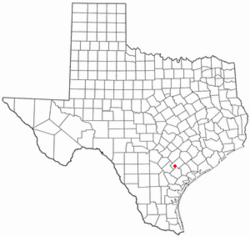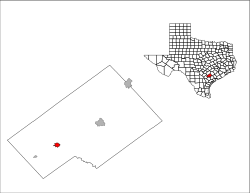Yorktown, Texas facts for kids
Quick facts for kids
Yorktown, Texas
|
|
|---|---|

Downtown Yorktown
|
|

Location of Yorktown, Texas
|
|
 |
|
| Country | United States |
| State | Texas |
| County | DeWitt |
| Area | |
| • Total | 1.73 sq mi (4.47 km2) |
| • Land | 1.73 sq mi (4.47 km2) |
| • Water | 0.00 sq mi (0.00 km2) |
| Elevation | 276 ft (84 m) |
| Population
(2020)
|
|
| • Total | 1,810 |
| • Density | 1,186.34/sq mi (458.11/km2) |
| Time zone | UTC-6 (Central (CST)) |
| • Summer (DST) | UTC-5 (CDT) |
| ZIP code |
78164
|
| Area code(s) | 361 |
| FIPS code | 48-80584 |
| GNIS feature ID | 1377672 |
Yorktown is a city located in DeWitt County, Texas, United States. In 2020, the city had a population of 1,810 people.
Contents
About Yorktown
Yorktown is in the southwestern part of DeWitt County. Two main roads, Highway 72 and Highway 119, meet on the west side of town. Highway 72 goes northeast about 16 miles to Cuero and southwest about 25 miles to Kenedy. Highway 119 goes northwest about 35 miles to Stockdale and south about 24 miles to Goliad. The city covers an area of about 4.5 square kilometers (1.7 square miles), all of which is land.
Who Lives in Yorktown?
| Historical population | |||
|---|---|---|---|
| Census | Pop. | %± | |
| 1880 | 430 | — | |
| 1890 | 522 | 21.4% | |
| 1900 | 846 | 62.1% | |
| 1910 | 1,180 | 39.5% | |
| 1920 | 1,723 | 46.0% | |
| 1930 | 1,882 | 9.2% | |
| 1940 | 2,081 | 10.6% | |
| 1950 | 2,596 | 24.7% | |
| 1960 | 2,527 | −2.7% | |
| 1970 | 2,411 | −4.6% | |
| 1980 | 2,498 | 3.6% | |
| 1990 | 2,207 | −11.6% | |
| 2000 | 2,271 | 2.9% | |
| 2010 | 2,092 | −7.9% | |
| 2020 | 1,810 | −13.5% | |
| U.S. Decennial Census | |||
In 2020, there were 1,810 people living in Yorktown. The city had 901 households and 562 families.
Here's a look at the different groups of people living in Yorktown in 2020:
| Group | Number of People | Percentage |
|---|---|---|
| White (not Hispanic or Latino) | 845 | 46.69% |
| Black or African American (not Hispanic or Latino) | 59 | 3.26% |
| Native American or Alaska Native (not Hispanic or Latino) | 4 | 0.22% |
| Asian (not Hispanic or Latino) | 2 | 0.11% |
| Other Race (not Hispanic or Latino) | 1 | 0.06% |
| Mixed/Multi-Racial (not Hispanic or Latino) | 21 | 1.16% |
| Hispanic or Latino | 878 | 48.51% |
| Total | 1,810 |
Lithuanian History in Yorktown
Yorktown is special because it has the oldest known Lithuanian-American community in the United States. The first Lithuanians arrived in Texas in 1852. They came from a part of Lithuania that was controlled by Germany at the time. These early settlers joined the German-American communities because their cultures were similar.
The most important reminder of Yorktown's Lithuanian past is the Smith Creek Lithuanian Cemetery. In the late 1900s, people whose families came from these early Lithuanian settlers helped fix up the cemetery. They put up a sign that says it's a Lithuanian cemetery and painted the Lithuanian flag. About 30 gravestones are still there.
A special memorial plaque in Yorktown tells the story of the Lithuanians in Texas. It explains that these immigrants settled near Yorktown around 1852. They came for religious and political reasons, arriving through ports like Galveston. They became farmers and American citizens, adding to the area's history. Some men from this community even fought in the American Civil War. The plaque also mentions the Jonischkies Cemetery, where many of these early settlers are buried. This plaque is one of the few Lithuanian memorial plaques in the U.S.
The Yorktown history museum has many items related to Lithuanian culture. You can see copies of old letters written in Lithuanian. There are also 19th-century Lithuanian tools, a fishing net, and cattle branding irons.
The first Lithuanians in Yorktown were Lutherans. They helped build the St. Paul Lutheran Church with local German families. The first church was built in 1874 and rebuilt in 1930. Some of the church's stained-glass windows even show Lithuanian family names.
Because of its unique history, Yorktown's Lithuanian community has been studied by many researchers. Several books and a documentary film have been made about this special community.
Yorktown's History
Yorktown was founded by Captain John York and Charles Eckhardt. It was named after Captain John York, a famous Indian fighter. He led a group of citizens who helped defeat General Cos in 1835 during the Siege of Béxar. For his service, Captain York received a lot of land in the Coleto Creek area.
Charles Eckhardt had a business in Indianola, which was a big seaport back then. Eckhardt helped in the Texas Revolution. He might have met Captain York during their military service. Eckhardt hired John A. King to map out a road from Indianola through Yorktown to New Braunfels. This road became known as the Old Indianola Trail.
This new road, started in 1848, was very important for this part of Texas. It was 20 miles shorter than the old route. Yorktown became a key stop for freighters, prairie schooners, trail drivers, and stagecoaches. These travelers brought mail and passengers through the town.
In early 1848, after the town was planned, the founders offered 10 acres of land and a free lot to the first ten families who settled there. Many German, Bohemian, Lithuanian, and Polish families moved to Yorktown. They helped turn the area into a successful place.
The first house in Yorktown was built in May 1848 by Peter Metz and John Frank for Charles Eckhardt. It was a log cabin. Charles's brother, Caesar Eckhardt, later lived in this house. Caesar founded C. Eckhardt and Sons Mercantile Company, which was a very important business in western DeWitt County for 50 years.
Sadly, neither of the founders saw the town grow much. In October 1848, Captain York and his son-in-law, James Madison Bell, were killed in a battle with Indians. They were buried together in the Yorktown Cemetery. A historical marker shows where Captain York's grave is. In 1852, Charles Eckhardt died at sea from yellow fever while returning from Central America. He is buried in New Orleans. The Eckhardts had no children, but the Yorks had ten.
The Catholic community built a church in 1867, and the Lutherans built theirs in 1872. A very old oak tree stands on the lawn of the Lutheran church. Yorktown officially became a town in 1871.
Western Days Celebration
Western Days is a fun, three-day town celebration held every year on the third weekend of October. It takes place downtown at the city park. The event includes a carnival, a barbecue cook-off, and tournaments for horseshoes and washers. There's also a quilt show, a poker run, and street dancing. Many food booths and art and craft stands fill the streets.
The celebration officially started in 1958. However, its roots go back to the early 1950s. Leslie and Cecil Mueller's M&M Rodeo Company used to organize cowboy parades to promote their rodeo shows. Leslie Mueller would gather rodeo cowboys to ride horses through downtown Yorktown. These parades were quite exciting!
In the spring of 1958, Mueller worked with the Yorktown Chamber of Commerce to plan a Western parade for the whole community. They also planned a two-day rodeo. Mueller offered handmade boots as a prize for the best-dressed cowgirl in the parade. The Chamber offered boots for the best-dressed cowboy. Other local businesses also gave prizes.
The Yorktown News newspaper reported that the first parade was planned very quickly. But it was a huge success because of how much local businesses helped. On Saturday, March 29, 1958, a large crowd came to see the parade. It was led by the VFW Color Guard. The Yorktown High School marching band, called the "Bronc Busters," followed. The parade also featured the famous Lone Star Brewing Company Shetland Pony Hitch. These ponies wore tiny cowboy hats and pulled a miniature covered wagon. Another highlight was Monroe Woods' mustang team pulling a frontier wagon. Sparky, the rodeo clown, walked at the end of the parade.
The Yorktown News also said that most people went to Les Mueller's Smith Creek Arena for the rodeo after the parade. The rodeo was a "thriller" with "mean, ornery broncs and bulls." It had many exciting moments. Rodeo events included calf roping, bareback bronc riding, bull riding, and the ladies' barrel race. The show also featured Tab Evans and his trained hog, Pork Chop, and his trained dog, Wheeler.
After the first successful parade and rodeo, the Yorktown Chamber of Commerce decided to hold the celebration every year. In 1962, they crowned the first Western Days queen, Jo Ann Boone. For almost 20 years, M&M Rodeo Company put on a rodeo with the Western Days celebration. Famous cowboys like Bud Humphrey and Phil Lyne performed in these rodeos.
In 1962, Mueller built a new arena north of Yorktown, and the rodeos moved there. In July 1963, Mueller died after a horseback riding accident. However, his wife, Cecil Olivia Gilliam Mueller, and son Don continued to manage the rodeo company. They produced their last rodeo in Yorktown in 1975.
Today, Western Days still brings many people to Yorktown. Visitors come from all over the country. They enjoy the Grand Parade, live music, chili cook-offs, contests, shopping, and the friendly spirit of the town. This spirit is what started the celebration over 55 years ago.
Notable People
- Harlon Block – He was one of the marines in the famous photo Raising the Flag on Iwo Jima.
- Ox Eckhardt – A professional baseball player in Major League Baseball.
Photo Gallery
See also
 In Spanish: Yorktown (Texas) para niños
In Spanish: Yorktown (Texas) para niños



